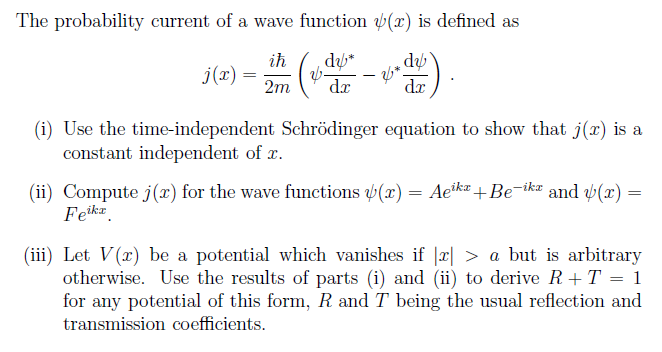Find #j(x)#. What type of wave this is describing?

1 Answer
The probability current,
Well, if we want to show that
#j(x)# is a constant w.r.t.#x# , we just need
#(dj(x))/(dx) = 0# .So... we first find the form of
#(dj(x))/(dx)# .
#(dj(x))/(dx) = d/(dx)[(iℏ)/(2m)(psi (dpsi^"*")/(dx) - psi^"*" (dpsi)/(dx))]#
#= (iℏ)/(2m)(psi (d^2psi^"*")/(dx^2) + cancel((dpsi)/(dx) (dpsi^"*")/(dx)) - psi^"*" (d^2psi)/(dx^2) - cancel((dpsi^"*")/(dx)(dpsi)/(dx)))# The time-independent Schrodinger equation is
#-ℏ^2/(2m) (d^2psi)/(dx^2) + V(x)psi = Epsi# so we have:
#(d^2psi)/(dx^2) = -(2m(E-V(x)))/(ℏ^2)psi#
#(d^2psi^"*")/(dx^2) = -(2m(E-V(x)))/(ℏ^2)psi^"*"# Therefore:
#(dj(x))/(dx) = (iℏ)/(2m)(psi [-(2m(E-V(x)))/(ℏ^2)psi^"*"] - psi^"*" [-(2m(E-V(x)))/(ℏ^2)psi])#
#= -(iℏ)/(2m)((2m(E-V(x)))/(ℏ^2)psipsi^"*" - (2m(E-V(x)))/(ℏ^2)psi^"*"psi)# Obviously,
#psi# commutes with#psi^"*"# , so
#color(blue)((dj(x))/(dx)) = -(iℏ)/(2m) cdot (2m(E-V(x)))/(ℏ^2) cdot (psi^"*"psi - psi^"*"psi)#
#= color(blue)(0)# Thus,
#j(x)# is a constant w.r.t.#x# .
We consider the plane wave
#psi(x) = Ae^(ikx) + Be^(-ikx)# , with#k# being the usual wave number#k = p/ℏ# .It has some probability of reflection or transmission (we do not know what, until we know the properties of
#V# as a function of#x# ), and its derivatives are:
#(dpsi)/(dx) = ikAe^(ikx) - ikBe^(-ikx)#
#(dpsi^"*")/(dx) = -ikA^"*"e^(-ikx) + ikB^"*"e^(ikx)# Therefore, for this
#psi(x)# :
#color(blue)(j_1(x)) = (iℏ)/(2m)[(Ae^(ikx) + Be^(-ikx))(-ikA^"*"e^(-ikx) + ikB^"*"e^(ikx)) - (A^"*"e^(-ikx) + B^"*"e^(ikx))(ikAe^(ikx) - ikBe^(-ikx))]#
#= (iℏ)/(2m)[-ikA A^"*" + cancel(ikAB^"*"e^(2ikx)) - cancel(ikBA^"*"e^(-2ikx)) + ikBB^"*" - ikA A^"*" + cancel(ikBA^"*"e^(-2ikx)) - cancel(ikAB^"*"e^(2ikx)) + ikBB^"*"]#
#= (iℏ)/(cancel(2)m)[cancel(2)ik(B B^"*" - A A^"*")]#
#= color(blue)((ℏk)/m(A A^"*" - B B^"*"))# For
#psi(x) = Fe^(ikx)# ,
#(dpsi)/(dx) = ikFe^(ikx)#
#(dpsi^"*")/(dx) = -ikF^"*"e^(-ikx)# Thus:
#color(blue)(j_2(x)) = (iℏ)/(2m)[Fcancel(e^(ikx))(-ikF^"*"cancel(e^(-ikx))) - F^"*"cancel(e^(-ikx))(ikFcancel(e^(ikx)))]#
#= (iℏ)/(2m)[-ikF F^"*" - ikF F^"*"]#
#= (iℏ)/(cancel(2)m)[-cancel(2)ikF F^"*"]#
#= color(blue)((ℏk)/(m)F F^"*")# The terms
#A A^"*"# , etc. indicate the probability of the event occurring corresponding to its#e^(pmikx)# term. Of course, this means that
- the first plane wave has some finite probability of moving forward (
#e^(ikx)# ) or moving backward (#e^(-ikx)# ).- the second plane wave obviously has a
#100%# probability of moving forward (#e^(ikx# ) (how else would it move?).
This is a pretty roundabout way of simply saying to place a barrier of arbitrary height in front of the particle of width
#2a# centered at#x = 0# :
#V(x) = {(0, |x| > a),(V_0, -a <= x <= a):}#
![]()
Here we define
#k# on the left of the barrier and#k'# on the right of the barrier (#k ne k'# ). That is, we define the wave functions for the left and right of the barrier as:
#psi_L(x) = Ae^(ikx) + Be^(-ikx)#
#psi_R(x) = Fe^(ik'x)# where
#psi_R(x)# necessarily has no#Ge^(-ik'x)# term so that the particle does not double back.Therefore, what we got in
#(ii)# is now specified:
#j_L(x) = (ℏk)/m(A A^"*" - B B^"*") = "const"#
#j_R(x) = (ℏk')/mFF^"*" = "const"# From
#(i)# , since#j(x)# is a constant w.r.t.#x# (which we see here)#j_L(x) = j_R(x) = "same const"# .The reflection coefficient is defined as
#R = (B B^"*")/(A A^"*")# And the transmission coefficient is defined as
#T = (k')/(k)(F F^"*")/(A A^"*")# First, we can say that
#overbrace(cancel((ℏ)/m)k(A A^"*" - B B^"*"))^(j_L(x)) = overbrace(cancel((ℏ)/m)k'FF^"*")^(j_R(x))# or that
#-(A A^"*" - B B^"*") = B B^"*" - A A^"*" = -(k')/k FF^"*"# Therefore, we use our results to find:
#color(blue)(R + T) = (B B^"*")/(A A^"*") + (k')/(k)(F F^"*")/(A A^"*")#
#= (B B^"*" + A A^"*" - A A^"*")/(A A^"*") + (k')/(k)(F F^"*")/(A A^"*")#
#= 1 + (B B^"*" - A A^"*")/(A A^"*") + (k')/(k)(F F^"*")/(A A^"*")#
#= 1 - cancel((k')/k (FF^"*")/(A A^"*") + (k')/(k)(F F^"*")/(A A^"*"))#
#= color(blue)(1)# This result should make sense.
Obviously, a particle can only reflect or transmit through a potential barrier. There is nothing else it can physically do, so this total probability should be
#100%# .

